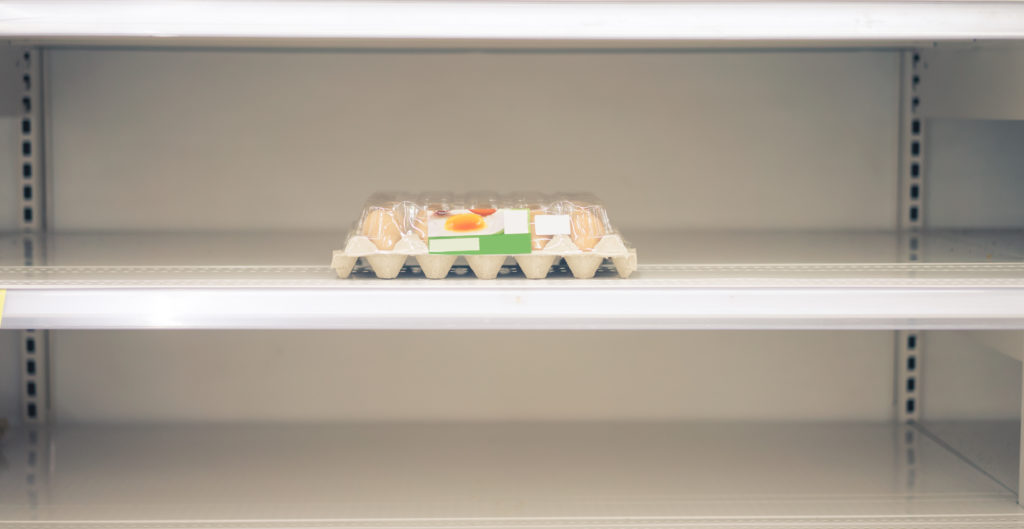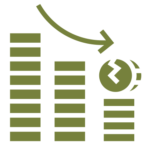COVID-19 has challenged numerous global and U.S. supply chains, shedding light on weaknesses in the systems. The food supply chain certainly was not immune. While bare shelves and empty coolers are eye-opening and may seem temporary to consumers, the impacts on the disruption will have long-lasting implications from an economic, environmental, and social standpoint.

In this fourth and final installment of our Unintended Consequences series, we explore the implications and future outlooks for consumers as it relates to the egg supply chain.
Consumers have seen several scenarios play out due to COVID-19. With the egg industry, first came the shortage on retail shelves and a temporary increase in cost. As dominoes fell around them, consumers got a sneak peek into how their food system operates, but few were able to completely grasp the complexities of getting food from farms to new end-users, in this case, the grocery store.
As we mentioned previously, two-thirds of the egg industry grows eggs for shell eggs or retail use. The other one-third of the industry grows eggs for egg products. Unfortunately, there is little overlap between the production systems and therefore transitions from egg product to shell eggs for retail use were not as easily attained, causing a shortage on one end while the other side had a surplus. While the shortage of eggs in a retail market was temporary, there have been some long-term economic, environmental, and social impacts that will benefit bottom lines moving forward.
 Long-Term Economic Impacts:
Long-Term Economic Impacts:
Product Availability at Restaurants, Cafeterias, Schools: As restrictions of shelter-in-place orders lift, and consumers return to a new “normal”, there may be an impending shortage of eggs available at food service entities. While there are supplies to meet demands now, we must be cognizant of the volume of birds temporarily taken out of production through molting and permanently through euthanasia, a number that is still not readily available, but it is likely to be significant. Building up production to pre-COVID-19 levels will take time. Between rebuilding flocks, there are only so many chicks available annually, and while growing them to egg-producing maturity, a 16-20 week process, supplies will be limited within the egg product sector. The length of time and financial impact are areas that need to be examined further.
Production Losses: Rural communities may also be impacted economically from these shifts in consumer spending. The Midwest is the epicenter of egg product production and thus will see scenarios play across the Heartland. There will be some farms with significant debt loads that cannot weather this storm. Losses of jobs, local tax revenue, and more will add up for these individuals and communities at-large, adding more burden on already financially strapped rural America.
 Environmental Impacts:
Environmental Impacts:
Resources– Food waste is an environmental concern. Dumping liquid egg products and hen carcasses can be viewed as just that – food waste. While we’ve explored the reasons whythis happened, we still cannot ignore the implications of throwing away food. There is more to dumping than just the economic impacts to the producers. There are also wasted resources: those needed to produce the feed and also grow the flocks. What is the environmental cost of having those resources wasted? What sort of resources will it take for the industry to get back to “normal”?
Landfill Waste – Another thing to consider is the additional landfill waste brought from these changes. Rotting, wasted food produces methane gas – something climate scientists are already watching closely. What is the overall egg industry environmental impact when a percentage of products goes to landfills?
 Social Impacts
Social Impacts
Food Shortages/Security– The U.S. prides itself as an efficient, modern food system. For consumers, are their impacts on perception of our food security with shortages that will span for months to years? Are there impacts or movements to push for more ease in food pantry donations or local points of sale? What can the industry do to proactively manage changes or needs of the consumer?
Visuals of Euthanasia – While the egg industry has done a good job to date of managing the crisis of having to depopulate flocks, other parts of the food production industry have not faired so well – with visuals of mass euthanization and dead animals. What are the repercussions to workforce members whose day-to-day responsibility and self-actualization are centered on being caregivers when having to end the life of the flock prematurely? And the impacts on consumer’s from these visuals? Granted, we are leveraging experiences from depopulations due to diseases like high pathogenic avian influenza (HPAI), but depopulations triggered by economics may be different. And, are there lessons the egg industry can be learned from this experience to prepare for future crises?
This series has certainly laid out a broad range of perspectives for the egg industry and identified gaps for the industry consider further. At this point, there is still a lot of unknowns. But, that is the significance of bringing the industry together, sharing perspectives, borrowing from adjacent industries, and developing a plan of action moving forward.
Throughout this series, The Context Network has performed a deep dive into the intricacies of the egg industry by including perspectives spanning the supply chain. We’d like to thank United Egg Producers, Egg Industry Center, and Oskaloosa Foods for their contributions to this series.
If you’re interested in working with Context to work through these or any other issues, please contact me at matt.sv@contextnet.com


